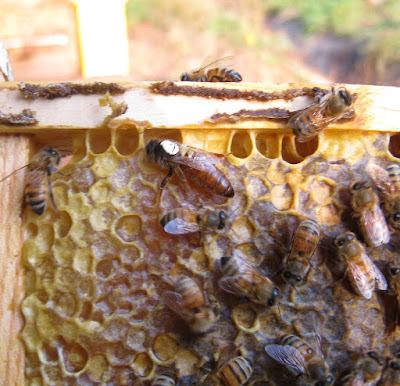MELISSA
Sunny
85°F
Going into Melissa to check on the handful of Swarm cups i saw the other day. Swarm Cups are what I call the little queen cups formed on the bottom of the frames, or in Swarm Position. She seems to have many bees now. I would say her population is High. I need to know if she is honey bound or just has no room left on the comb for the bees.
DHB2: frames
1 - Back filling with Nectar
2 - Back filling with Nectar
3 - Back filling with Nectar
4 - Solid eggs & larva
5 - Honey & Nectar
6 - Brood & some Drone cells, 4 swarm cups removed
7 - Brood & eggs, 3 swarm cups removed
8 - Solid eggs & larva
9 - Back filling with Nectar
10 - Back filling with Nectar, mostly full
DHB1: frames
1 - Back filling with Nectar, broken frame is fixed
2 - Medium Frame, mostly honey & back filling
3 - 1/2 Brood
4 - Medium Frame, brood & 2 swarm cups, drone cells
5 - Not fully drawn, 4 swarm cups, some pollen
6 - Brood, some pollen
7 - Medium Frame, brood & 2 swarm cups
8 - Pollen, little brood & honey
9 - Medium Frame, mostly pollen & honey
10 - Pollen, mostly honey
All the cups in the top box (DHB2) were removed. That way i can tip up the box later this week to see if the bees made more swarm cups. If they do it will be strong evidence of an intent to swarm. Which may lead to a Fall Split; that I really don't want to do. Fortunately the queen has yet to cease laying; a sign the colony is preparing to swarm. This, then, may be a false alarm.
Fall Splits are common and used by many beeks. I am unfamiliar with them, though, and don't want to learn about it offhandedly. To that end i have talked to the neighbor and she will take the four Medium frames back and use them to bolster two of her colonies. These were the original frames used to make the Spring Split that became Melissa. They came from one of my neighbors colonies back in May.
 |
| The bees took a Medium frame and made it a Deep frame |
The bees need more room. Normally one can add an empty frame in the brood nest. Then the bees perceive extra room. That can quell the urge to swarm. These Medium frames offer more than just empty frames. I will cut the extended comb off the bottom of the frames. Then rubber band the comb to the empty frames. This way the frames will already be accepted by the bees and provide additional space to build comb on to complete the frame. We'll try to get it done this week.
News just as big is the dramatic lessening of Drone Cells. There were very few left in the hive. I do not recall seeing any that were uncapped. I didn't have my glasses on so couldn't tell if any adult drones were walking around. It appears Mating season is coming to a close. This is another reason I'm not fond of creating a Fall Split at this time. The possibility of too few drones left to properly breed a new queen formed from a new split. A Virgin queen, or badly mated one, will not be able to take a colony through Winter. They'll all die off after a few freezes. If i were to make Fall Splits I would have done it at the beginning of the month.
- - - - - - - - -
Afterward the news paper in Nuc #5 was removed. I didn't look through the colony but did see where the bees might be drawing out comb.
Additionally every Colony was feed one gallon of 1:1 syrup today. Each gallon also had 1 tbsp of Apple Cider Vinegar and a drop each of thyme & peppermint essential oils.
*_____________________________☼______________________________*






















































